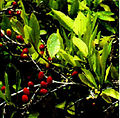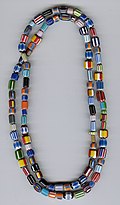Difference between revisions of "AY Honors/Currency (Template)/Answer Key"
| Line 1: | Line 1: | ||
| − | {{honor_header|2|1945|Arts and Crafts|General Conference|Currency_Honor.png}} | + | {{honor_header|2|1945|Arts and Crafts|General Conference|Currency_Honor.png|secondary=true}} |
==1. Relate briefly the story of barter, showing three reasons why money came into being and naming at least ten strange forms of money used in place of coins or currency. == | ==1. Relate briefly the story of barter, showing three reasons why money came into being and naming at least ten strange forms of money used in place of coins or currency. == | ||
'''Barter:''' as a dictionary puts it, ''barter'' is the exchange of something you own for something else that someone else owned. For example, if I raised chickens, and you grew apples, and I wanted some apples and you wanted a chicken, we would come to an agreement to exchange my chicken(s) for your apple(s). | '''Barter:''' as a dictionary puts it, ''barter'' is the exchange of something you own for something else that someone else owned. For example, if I raised chickens, and you grew apples, and I wanted some apples and you wanted a chicken, we would come to an agreement to exchange my chicken(s) for your apple(s). | ||
Revision as of 02:33, 9 July 2014
1. Relate briefly the story of barter, showing three reasons why money came into being and naming at least ten strange forms of money used in place of coins or currency.
Barter: as a dictionary puts it, barter is the exchange of something you own for something else that someone else owned. For example, if I raised chickens, and you grew apples, and I wanted some apples and you wanted a chicken, we would come to an agreement to exchange my chicken(s) for your apple(s).
After a while, I had enough of apples, and wanted something else. My other neighbor was vegetarian, and grew corn, but he did not want chickens. I found out that he also liked apples, so I bartered my chickens for your apples, and then traded the apples I got for my neighbor's corn. In a clumsy way, the apples were a medium of exchange, because they allowed me to trade for what I wanted. Unfortunately, you did not always want chickens, and apples were not always in season, so there were times in the year that I could not trade.
Simply put, a medium of exchange is a substitute used in trade to avoid the inconvenience of the barter system. This allowed the value of your apples, the corn, and my chickens to be valued differently. For example, I did not believe that I should only get one apple for one chicken. The chicken is bigger than an apple. Perhaps the first medium of exchange were stones. I would trade my chicken for four stones, and you would trade your apples for one stone, and the corn would be traded for two stones.
Very soon, we decided stones would not be a good medium of exchange, because:
- it was not very portable
- it could not be easily divided
- it was heavier than it was worth
- sometimes we could not recognize it
- and the neighbor's kid found a rockpile on the other side of the stream
Fast forward a few years, and currency has now been developed. Currency is a unit of exchange, which allows goods and services to be exchanged. It is one form of money (where money is anything that serves as a medium of exchange, a store of value, and a standard of value).
Unique forms of money
http://en.wikipedia.org/wiki/History_of_money
2. Relate briefly the history of coinage and paper currency in your country, making sure to mention the dates of the establishment of any mints or engraving plants. Also discover some change in the metal composition of a coin, giving any interesting highlights concerning such a change.
3. Explain how money is distributed in your country.
4. Define the following terms:
- a. Alloy
- An alloy is a combination of two or more elements, at least one of which is a metal, and where the resulting material has metallic properties. The resulting metallic substance usually has different properties (sometimes significantly different) from those of its components. Nearly all coins are made of alloys.
- b. Altered Date
- A coin that has had its date altered in an attempt to deceive someone into thinking it is more valuable than it really is.
- c. Buffed Coins
- A buffed coin is one that's been polished to make it look like an uncirculated or proof coin. Buffing a coin wears down its original surface, reducing its value.
- d. Cast Coins
- Coins which are made by pouring a molten alloy into a mold.
- e. Clad Coinage
- Coins made of layers, like a metal sandwich.
- f. Commemorative
- Commemorative coins are legally issued coins with a design intended to commemorate or draw attention to some event or person. They are so called to distinguish them from regular issue coinage.
- g. Die
- An engraved tool used for stamping a design onto a coin.
- h. Field
- The field is the background—the part of the coin that shows no picture or words.
- i. Inscription
- An inscription is any letter, word, or phrase pressed into the surface of a coin.
- j. Lettered Edge
- A coins having letters written on its edge.
- k. Mint Mark
- The mint mark is a small letter that tells which mint branch struck the coin.
- l. Obverse
- The front side of currency or a coin (often called "heads" on a coin).
- m. Planchet
- A blank disc of metal from which a coin is made.
- n. Proof
- Proof coins use a special process that gives them a shiny, mirror-like background and a "frosted" relief. Proof sets are made every year for all of our circulating coins. Like uncirculated coins, proof coins are not meant to be spent.
- o. Reeded Edge
- The reeded edges still found on many coins (always those that were once made of gold or silver, even if not so now) were originally designed to show that none of the valuable metal had been shaved off the coin. These show up as ridges along the edge of the coin.
- p. Reverse
- The back side of currency or a coin (often called "tails" on a coin).
- q. Series
- A set of coins of the same denomination but with different designs introduced on a regular basis. The series will have a unifying theme.
- r. Type
- A coin design that does not change from year to year (except for the date and mint marks).
- s. Whizzed Coins
- A whizzed coin has been wire brushed or burnished, often on a wheel, for the same reason. Whizzing a coin wears down its original surface, reducing its value.
- t. Wire Edge
- When a coin is made, the blank is placed inside a collar and the coin is struck with a die. Sometimes a very thin piece of metal from the blank will flow out between the collar and the die. This is called the wire edge.
5. Describe the obverse and reverse for paper money of the six lowest denominations currently in use in your country.
<! fill in these templates as appropriate for your country>
| [[Image:|thumb|300px|Obverse side, featuring ]] | [[Image:|thumb|300px|Reverse side, featuring ]] |
| [[Image:|thumb|300px|Obverse side, featuring ]] | [[Image:|thumb|300px|Reverse side, featuring ]] |
| [[Image:|thumb|300px|Obverse side, featuring ]] | [[Image:|thumb|300px|Reverse side, featuring ]] |
| [[Image:|thumb|300px|Obverse side, featuring ]] | [[Image:|thumb|300px|Reverse side, featuring ]] |
| [[Image:|thumb|300px|Obverse side, featuring ]] | [[Image:|thumb|300px|Reverse side, featuring ]] |
| [[Image:|thumb|300px|Obverse side, featuring ]] | [[Image:|thumb|300px|Reverse side, featuring ]] |
6. Know how coins are graded in quality by collectors.
- Uncirculated (abbreviated "unc"). Such a coin looks as new as the day it was minted—"minty fresh," if you will. This one shows not even the slightest sign of wear or contact.
- Extremely Fine (EF) or About Uncirculated. This coin is almost perfect except for slight wear or flaws.
- Very Fine (VF). It's easy to see that this coin has been used because the highest points are slightly flattened...but the rest of the details are fine and there are no nicks or scratches.
- Fine (F). A coin in Fine condition is pretty worn and flattened. But even though there may be minor nicks and blemishes, the details are still clear and its general look is pleasing.
- Very Good (VG). This coin is quite worn and the rim is flat, although the words are still readable.
- Good (G). You can make out the main design and lettering on this one, but it's so worn and scratched that it's not very collectible—unless you can't find anything better.
- Uncurrent. This is not a grading term, but it describes a coin that's so badly worn that it weighs less than it should. You can tell what it is and it still works in machines, but merchants and banks may not take it.
- Mutilated. These coins are not just worn out but are bent, broken, stuck together, or incomplete.
7. Collect and mount a type set of coins from your country of any date currently being minted or in circulation. Proof, commemorative, rare, silver, or expensive coins are not needed. In your collection:
a. Possess at least one coin from each mint in the type set.
b. Locate and identify the mint mark (if any) on each coin.
c. Locate and identify the initials (if any) of each coin's designer(s).
8. Do two of the following:
a. Make enlarged drawings of both sides of ten different denominations or forms of coins for your country no longer in circulation.
b. Collect, identify, and mount 25 different foreign coins. No two coins alike.
c. Collect and mount a type set of coins from your country minted during the 20th Century.
All the coins in a type set have the same design—for instance, Lincoln cents. What's different about each coin is its date and mint mark. Find a coin you love and collect one from every year it was made and from each mint branch that made it. If the coin is still being made, add new ones to your collection every year.
d. Collect and mount a date set of series of coins for your country beginning with your birth year. (Commemorative, gold, proof, expensive, or rare coins need not be included.)
Note: Facts About United States Money (free), Office of the Secretary of the Treasury, U.S. Treasury Department, Washington, D.C. 20025. Facts about your country's currency may be obtained from the government treasury department.
References
The following are links for pages listing the various currencies around the world. You should be able to use them to fill in many of the blanks above.







